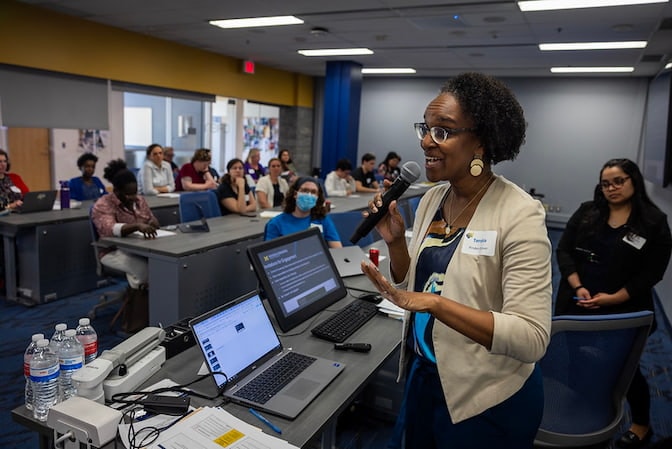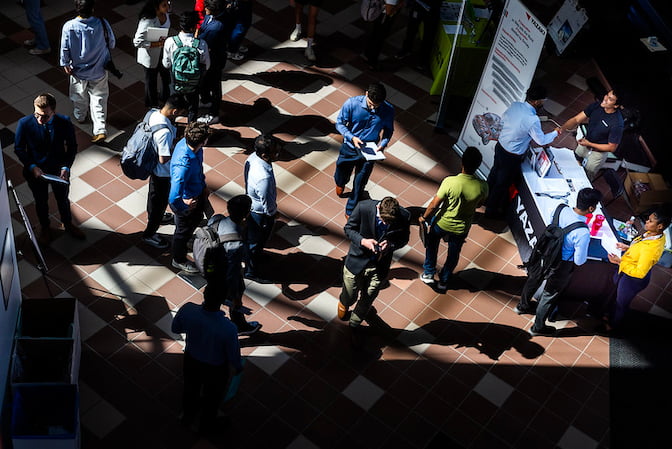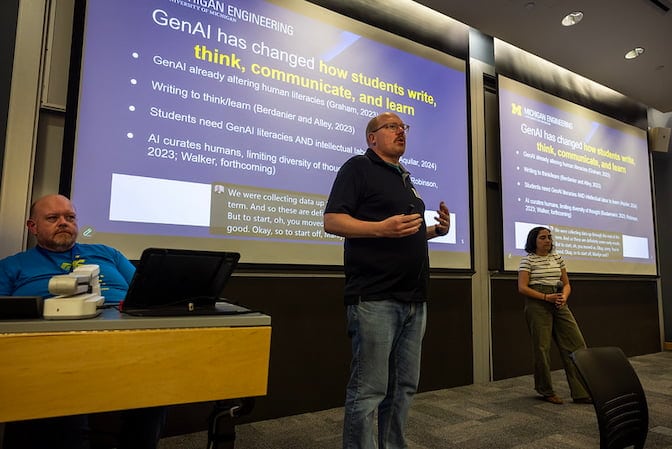
Using GenAI without hindering learning: Students want guidance
At Engineering Education Innovation event, educators shared research, ideas and student perspectives.

At Engineering Education Innovation event, educators shared research, ideas and student perspectives.
Generative AI has already changed how students write, think, communicate and learn, and it’s time to bring them into the conversation. That’s the message faculty in Michigan Engineering’s technical communication program delivered during a session at the College’s annual Engineering Education Innovation (EEI) Days Symposium.
Harnessing artificial intelligence was a common theme at this year’s EEI Days. Sessions covered how to use AI to create “transparent assignments” that clarify learning goals and evaluation criteria, and a case study on building an on-demand platform where student teams can get fast, accurate answers, enhancing experiential education. Browse videos of all the sessions.

Explore the forefront of AI
at Michigan Engineering
The Student Voices on Generative AI session shared insights and recommendations from a year-long study on how engineering undergraduate students use GenAI to develop academic expertise, and how they feel about its benefits and limitations.
“As we looked at the landscape on GenAI, we saw that it’s focused on teacher-centric issues. What we needed more of were student-centered perspectives,” said Dawn Zeng, a recent School of Information master’s graduate involved in the project.
“Students are stakeholders. AI usage impacts them and matters to them. Students perceive that things are changing and they want to be part of the conversation.”
The study drew on 27 interviews and 182 survey responses from Fall 2024 and Winter 2025. The researchers found:

Students turned to AI most often for help learning concepts in challenging courses like math and physics. Many described GenAI as a tutor, standing in for graduate student instructors (GSIs), faculty members or friends.
“I could email my physics GSI and wait like a really long time for a response,” one student said. “Or I can just open a new tab and get an answer right now.”
Panelists pointed to an important shift.
“This raises new questions about how students conceptualize different roles, such as tutor or GSI, and how that introduces different power dynamics,” said Colleen Hart, lecturer III in the Program in Technical Communication. “Is there more freedom for students to make decisions about their learning process? If expertise is required to use a tool but it also exists within the tool, how is this negotiated?”
Time pressure plays a major role. Many reported relying on GenAI when juggling too many credits or deadlines. Some described using it just to finish an assignment, intending to return to the material later—though they rarely did. And GenAI’s distillations of lecture transcripts or slides had served as passable substitutes for going to class.

“Summarizing the transcripts of lectures was the most surprising and demoralizing finding for me,” said Clay Walker, lecturer III in technical communication. “I knew some students were listening at two times the speed and multitasking, but I didn’t expect this.”
Writing process answers pleasantly surprised the researchers.
“Students are not really using it for writing as much as we thought they would,” said Mariel Krupansky, lecturer III in technical communication. “They definitely expressed concerns about the negative impacts it could have on creativity, like generating ideas, style and who owns the content.”
In interviews, studentse worried about layers of consequences—from their own ability to learn, to their job preparedness and success, and ultimately to the field of engineering overall.
“Students are thinking about how GenAI might affect their ability to solve problems, think critically and learn effectively,” Walker said.
One student said, “I just worry that if people don’t adjust accordingly, students are going to not have the skills they need for their brain to properly develop, and then they’re not going to have the skills for their future job.”
Computer science majors especially feared jobs might not even be there when they graduated.

Still, students recognize the need to adapt. “Learning how to use it responsibly is something that I think every engineer will need to think about and learn how to do going forward,” one student said.
This presents an urgent challenge for educators, panelists said. They recommend:
“Being an engineer doesn’t mean just having a degree. It means being able to think through problems in a certain way that people recognize as an engineer. It means using certain kinds of approaches and tools. We’re helping students develop an identity as an engineer and generative AI has entered into this stream of forming expertise,” Walker said. “We need to support student learning as a matter of intellectual development and not just academic dishonesty.”
The study was supported by grants from the College of Engineering’s Enhancing Engineering Education program and the U-M Center for Academic Innovation’s Academic Innovation Fund.